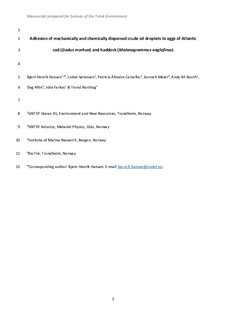| dc.contributor.author | Hansen, Bjørn Henrik | |
| dc.contributor.author | Sørensen, Lisbet | |
| dc.contributor.author | Almeida Carvalho, Patricia | |
| dc.contributor.author | Meier, Sonnich | |
| dc.contributor.author | Booth, Andy | |
| dc.contributor.author | Altin, Dag | |
| dc.contributor.author | Farkas, Julia | |
| dc.contributor.author | Nordtug, Trond | |
| dc.date.accessioned | 2018-08-16T15:44:44Z | |
| dc.date.available | 2018-08-16T15:44:44Z | |
| dc.date.created | 2018-07-04T09:59:51Z | |
| dc.date.issued | 2018-11-01 | |
| dc.identifier.citation | Science of the Total Environment. 2018, 640-641 138-143. | nb_NO |
| dc.identifier.issn | 0048-9697 | |
| dc.identifier.uri | http://hdl.handle.net/11250/2558340 | |
| dc.description.abstract | Crude oil accidentally spilled into the marine environment undergoes natural weathering processes that result in oil components being dissolved into the water column or present in particulate form as dispersed oil droplets. Oil components dissolved in seawater are typically considered as more bioavailable to pelagic marine organisms and the main driver of crude oil toxicity, however, recent studies indicate that oil droplets may also contribute. The adhesion of crude oil droplets onto the eggs of pelagic fish species may cause enhanced transfer of oil components via the egg surface causing toxicity during the sensitive embryonic developmental stage. In the current study, we utilized an oil droplet dispersion generator to generate defined oil droplets sizes/concentrations and exposed Atlantic cod (Gadus morhua) and haddock (Melanogrammus aeglefinus) to investigate if the potential for dispersed oil droplets to adhere onto the surface of eggs was species-dependent. The influence of a commercial chemical dispersant on the adhesion process was also studied. A key finding was that the adhesion of oil droplets was significantly higher for haddock than cod, highlighting key differences and exposure risks between the two species. Scanning electron microscopy indicates that the differences in oil droplet adhesion may be driven by the surface morphology of the eggs. Another important finding was that the adhesion capacity of oil droplets to fish eggs is significantly reduced (cod 37.3%, haddock 41.7%) in the presence of the chemical dispersant. | nb_NO |
| dc.language.iso | eng | nb_NO |
| dc.rights | Attribution-NonCommercial-NoDerivatives 4.0 Internasjonal | * |
| dc.rights.uri | http://creativecommons.org/licenses/by-nc-nd/4.0/deed.no | * |
| dc.subject | Petroleum | nb_NO |
| dc.subject | Fish embryo | nb_NO |
| dc.subject | Adhesion | nb_NO |
| dc.subject | Arctic | nb_NO |
| dc.subject | Dispersant | nb_NO |
| dc.title | Adhesion of mechanically and chemically dispersed crude oil droplets to eggs of Atlantic cod (Gadus morhua) and haddock (Melanogrammus aeglefinus) | nb_NO |
| dc.title.alternative | Adhesion of mechanically and chemically dispersed crude oil droplets to eggs of Atlantic cod (Gadus morhua) and haddock (Melanogrammus aeglefinus) | nb_NO |
| dc.type | Journal article | nb_NO |
| dc.type | Peer reviewed | nb_NO |
| dc.description.version | acceptedVersion | nb_NO |
| dc.rights.holder | © 2018 Elsevier B.V. All rights reserved. - Accepted manuscript © the author(s) 2018 | nb_NO |
| dc.source.pagenumber | 138-143 | nb_NO |
| dc.source.volume | 640-641 | nb_NO |
| dc.source.journal | Science of the Total Environment | nb_NO |
| dc.identifier.doi | 10.1016/j.scitotenv.2018.05.207 | |
| dc.identifier.cristin | 1595542 | |
| dc.relation.project | Norges forskningsråd: 280511 | nb_NO |
| dc.relation.project | Norges forskningsråd: 267820 | nb_NO |
| cristin.unitcode | 7566,6,0,0 | |
| cristin.unitcode | 7401,80,6,2 | |
| cristin.unitname | Miljø og nye ressurser | |
| cristin.unitname | Materialfysikk. Oslo | |
| cristin.ispublished | true | |
| cristin.fulltext | postprint | |
| cristin.qualitycode | 2 | |

